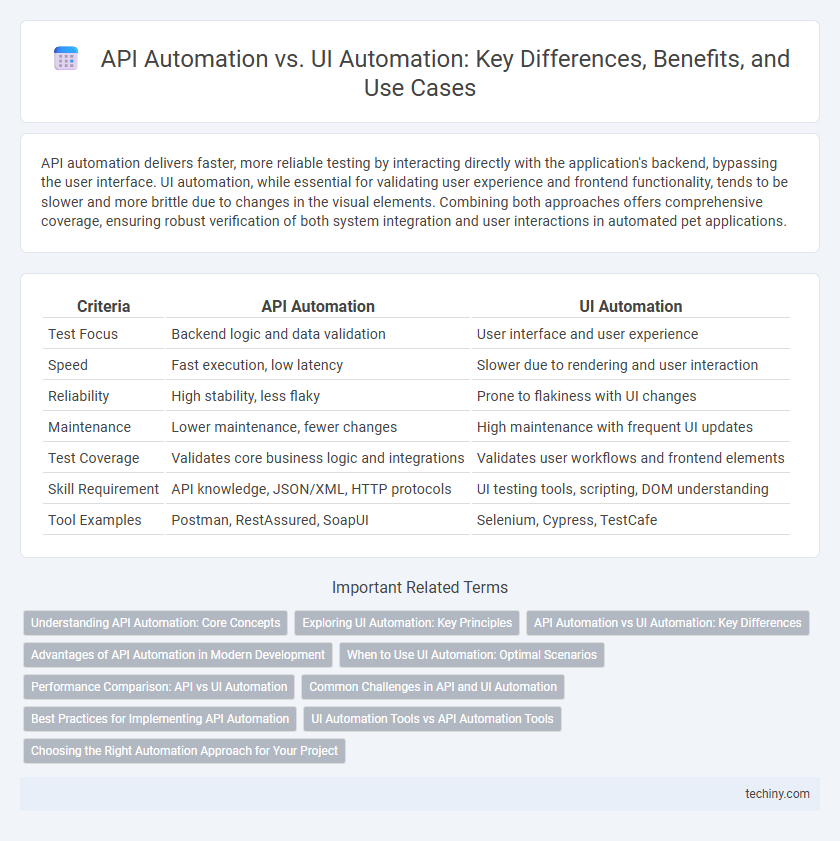API automation delivers faster, more reliable testing by interacting directly with the application's backend, bypassing the user interface. UI automation, while essential for validating user experience and frontend functionality, tends to be slower and more brittle due to changes in the visual elements. Combining both approaches offers comprehensive coverage, ensuring robust verification of both system integration and user interactions in automated pet applications.
Table of Comparison
| Criteria | API Automation | UI Automation |
|---|---|---|
| Test Focus | Backend logic and data validation | User interface and user experience |
| Speed | Fast execution, low latency | Slower due to rendering and user interaction |
| Reliability | High stability, less flaky | Prone to flakiness with UI changes |
| Maintenance | Lower maintenance, fewer changes | High maintenance with frequent UI updates |
| Test Coverage | Validates core business logic and integrations | Validates user workflows and frontend elements |
| Skill Requirement | API knowledge, JSON/XML, HTTP protocols | UI testing tools, scripting, DOM understanding |
| Tool Examples | Postman, RestAssured, SoapUI | Selenium, Cypress, TestCafe |
Understanding API Automation: Core Concepts
API Automation involves testing the application programming interfaces directly by sending requests and validating responses, ensuring faster execution and early detection of backend issues. It focuses on the business logic and data layer without the need for a user interface, enabling more stable and reliable test scripts. Core concepts include endpoint testing, request methods (GET, POST, PUT, DELETE), status code verification, and payload validation to ensure seamless integration and functionality.
Exploring UI Automation: Key Principles
UI automation focuses on interacting with the graphical user interface to simulate real user actions such as clicks, typing, and navigation, ensuring end-to-end testing of application workflows. Key principles include element identification using locators like XPath or CSS selectors, synchronization to handle dynamic content, and validation of visual components for UI consistency. UI automation tools such as Selenium and TestComplete facilitate script creation for repetitive tasks, improving testing efficiency and accuracy in detecting UI defects.
API Automation vs UI Automation: Key Differences
API automation tests the application's backend by directly interacting with endpoints, enabling faster execution and early detection of issues without relying on the user interface. UI automation validates user workflows through graphical interfaces, offering comprehensive end-to-end testing but often suffering from slower test cycles and higher maintenance costs. The key differences lie in speed, reliability, scope, and the level of integration, with API automation excelling in performance and stability, while UI automation focuses on user experience validation.
Advantages of API Automation in Modern Development
API automation offers faster execution and more reliable testing by interacting directly with the software's backend, bypassing the fragile user interface. It enables early detection of issues through continuous integration pipelines, reducing development time and costs. Scalability and easier test maintenance make API automation essential for modern agile and DevOps environments.
When to Use UI Automation: Optimal Scenarios
UI Automation is optimal for end-to-end testing where user interface interactions, such as clicking buttons, entering data, and navigating screens, must be validated to ensure a seamless user experience. It is essential for regression testing of complex workflows that cannot be fully covered by API Automation, especially when visual elements or front-end logic are critical. UI Automation is also valuable when testing applications with limited or no API support, making direct interaction with the interface the only way to verify functionality.
Performance Comparison: API vs UI Automation
API automation demonstrates significantly faster execution times compared to UI automation due to direct interaction with application endpoints, bypassing the rendering and manipulation of graphical elements. UI automation introduces overhead from browser rendering, DOM interaction, and event handling, resulting in slower test execution and increased flakiness. Performance metrics show API tests can run up to 70% faster than UI tests, enabling more efficient regression cycles and continuous integration pipelines.
Common Challenges in API and UI Automation
API automation and UI automation both face challenges such as maintaining test script reliability amid frequent application updates and managing test data consistency across environments. API automation struggles with handling complex authentication protocols and ensuring comprehensive endpoint coverage, while UI automation often encounters flaky tests due to dynamic user interfaces and varying browser compatibility. Effective error handling and seamless integration with CI/CD pipelines remain critical obstacles for both automation approaches.
Best Practices for Implementing API Automation
API automation requires designing modular, reusable test scripts that directly interact with endpoints to validate functionalities, ensuring faster execution and easier maintenance compared to UI automation. Implementing comprehensive data-driven tests and robust error handling improves test reliability and coverage across different scenarios. Integrating API automation within CI/CD pipelines enables continuous testing and early defect detection, optimizing overall development workflows.
UI Automation Tools vs API Automation Tools
UI automation tools like Selenium and Cypress excel in simulating user interactions with graphical interfaces, enabling end-to-end testing of web applications. In contrast, API automation tools such as Postman and SoapUI focus on validating backend services by testing endpoints, data integrity, and performance without the overhead of UI rendering. Choosing between UI automation tools and API automation tools depends on the testing scope, with UI tools offering comprehensive user experience validation while API tools provide faster, more reliable integration and functionality checks.
Choosing the Right Automation Approach for Your Project
API Automation delivers faster, more reliable testing by interacting directly with the application's backend, ideal for validating business logic and data integrity without UI dependencies. UI Automation simulates end-user interactions, essential for verifying user experience, interface consistency, and front-end functionality across multiple browsers and devices. Selecting the right automation approach depends on project requirements such as test coverage, execution speed, maintenance complexity, and application architecture.
API Automation vs UI Automation Infographic

 techiny.com
techiny.com